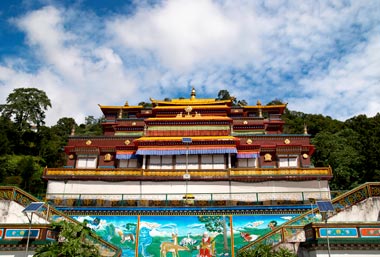Wedged between the Himalayan nations of Nepal and Bhutan, serene Sikkim lies at the foot of the immense Kanchenjunga, the world’s third highest peak. Thundering rivers, forests of magnolia and cardamom and pretty copses of fruit embellish this tiny corner of India blessed by nature’s bounty.
Much of the often jaw-dropping scenery of north Sikkim is inaccessible (visitors require permits). But if you do manage to make it, you can’t but help admire the beautiful alpine and (higher up) tundra terrain, the latter the home of such species as the snow leopard (rarely spotted) and the bharal, the Himalayan blue sheep.
Mangan, the administrative centre of north Sikkim, is located high up the Teesta Valley, and is the trailhead to a handful of interesting treks. Base yourself in this small town with its bustling bazaar.
History
Buddhism arrived in Sikkim via Tibet, in the 13th century, later taking on a local form in the 17th century, following the crowning of the first chogyal (“righteous king”) in 1642. Back then, the kingdom of Sikkim embraced Nepal’s east, northern Bengal, Darjeeling and western Bhutan. Over time, however, territory was lost to Nepal, Bhutan and the British. And when the British brought in Nepalese workers to work on the tea plantations at the end of the 19th century, a process was started that would lead to a decline in Tibetan influence in Sikkim; Nepalese today make up the majority in the state. Sikkim holds a special status within the Indian union (it’s a tax-free zone), and also holds strategic importance, going back to a time in the 1960s when the Chinese threat to the north was especially marked.
Geography
Rimmed to the north by the Tibetan plateau, often-glacial North Sikkim is home to remote river valleys (Teesta, Yumthang), and the sacred Lake Gurudongma, one of the highest lakes on the planet (17093ft, 5210m). The gorgeous Gurudongma, situated on the Tibetan plateau, is also the source of the Teesta River.
Weather
While the rainy season is best avoided, winters (November to February) get frightfully cold – some valleys in the icy north (Yumthang, Tsopta) see temperatures plummeting as early as October (going as low as -40C over the winter). The ideal time to visit the north of Sikkim is during early summer and summer (April, May, June), and just after the climax of the monsoons (September).
How to reach
Mangan, the district centre of Sikkim’s north, is north of Gangtok, and can be reached via the monastery town of Phodong. Singhik is further ahead (70km from Gangtok).







 Share Via
Share Via











